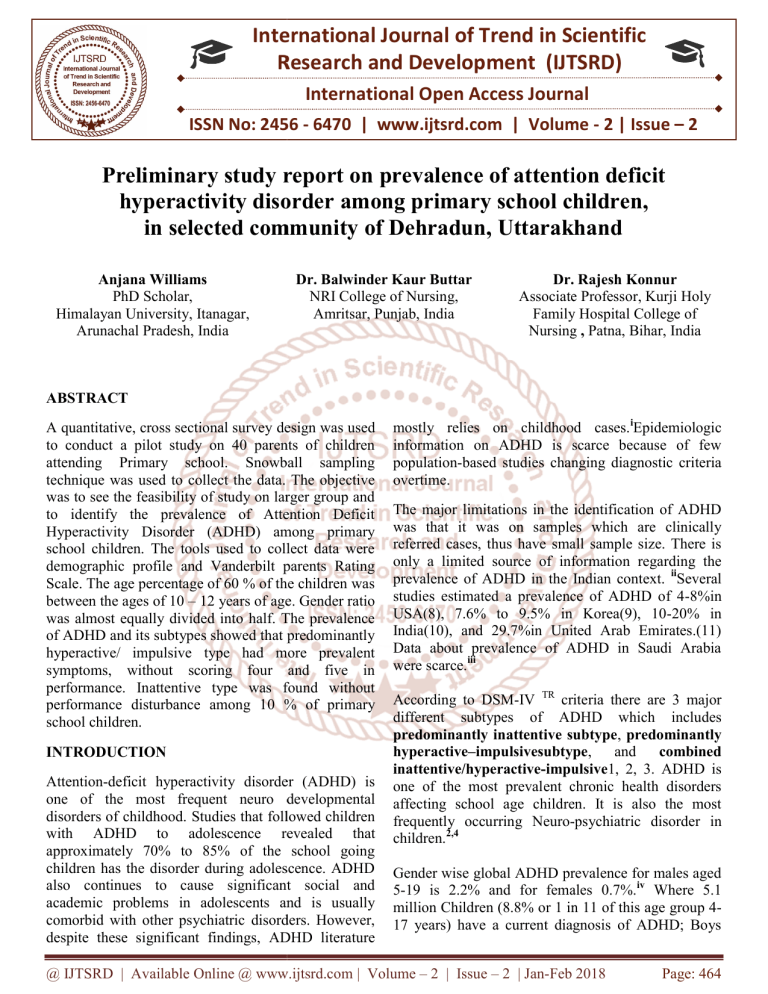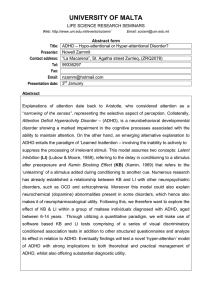
International Journal of Trend in Scientific
Research and Development (IJTSRD)
International Open Access Journal
ISSN No: 2456 - 6470 | www.ijtsrd.com | Volume - 2 | Issue – 2
Preliminary study report on prevalence of attention deficit
hyperactivity disorder among primary school children,
in selected community of Dehradun, Uttarakhand
Anjana Williams
PhD Scholar,
Himalayan University, Itanagar,
Arunachal Pradesh, India
Dr. Balwinder Kaur Buttar
NRI College of Nursing,
Amritsar, Punjab, India
Dr. Rajesh Konnur
K
Associate Professor,
Professor Kurji Holy
Family Hospital College of
Nursing , Patna, Bihar, India
ABSTRACT
A quantitative, cross sectional survey design was used
to conduct a pilot study on 40 parents of children
attending Primary school. Snowball sampling
technique was used to collect the data. The objective
was to see the feasibility of study on larger group and
to identify the prevalence of Attention Deficit
Hyperactivity Disorder (ADHD) among primary
school children. The tools used to collect data were
demographic profile and Vanderbilt parents Rating
Scale. The age percentage of 60 % of the children was
between the ages of 10 – 12 years of age. Gender ratio
was almost equally divided into half. The prevalence
of ADHD and its subtypes showed that predominantly
hyperactive/ impulsive type had more prevalent
symptoms,
ymptoms, without scoring four and five in
performance. Inattentive type was found without
performance disturbance among 100 % of primary
school children.
INTRODUCTION
Attention-deficit
deficit hyperactivity disorder (ADHD) is
one of the most frequent neuro developmental
disorders of childhood. Studies that followed children
with ADHD to adolescence revealed that
approximately 70% to 85% of the school going
children has the disorder during adolescence. ADHD
also continues to cause significant social and
academic problems in adolescents and is usually
comorbid with other psychiatric disorders. However,
despite these significant findings, ADHD literature
mostly relies on childhood cases.iEpidemiologic
information on ADHD is scarce because of few
population-based studies changing diagnostic criteria
overtime.
The major limitations in the identification of ADHD
was that it was on samples which are clinically
referred cases, thus have small sample size. There is
only a limited source of information regarding the
prevalence of ADHD in the Indian context. iiSeveral
studies estimated a prevalence of ADHD of 4-8%in
4
USA(8), 7.6% to 9.5% in Korea(9), 10-20%
10
in
India(10), and 29.7%in United Arab Emirates.(11)
Data about prevalence of ADHD in Saudi Arabia
were scarce.iii
According to DSM-IV TR criteria there are 3 major
different subtypes of ADHD which includes
predominantly inattentive subtype,
subtype predominantly
hyperactive–impulsivesubtype
impulsivesubtype,
and
combined
inattentive/hyperactive-impulsive
impulsive1, 2, 3. ADHD is
one of the most prevalent
ent chronic health disorders
affecting school age children. It is also the most
frequently occurring Neuro--psychiatric disorder in
children.2,4
Gender wise global ADHD prevalence for males aged
5-19
19 is 2.2% and for females 0.7%.iv Where 5.1
million Children
n (8.8% or 1 in 11 of this age group 44
17 years) have a current diagnosis of ADHD; Boys
@ IJTSRD | Available Online @ www.ijtsrd.com | Volume – 2 | Issue – 2 | Jan-Feb
Feb 2018
Page: 464
International Journal of Trend in Scientific Research and Development (IJTSRD) ISSN: 2456-6470
(12.1%) continue to be more than twice as likely as
girls (5.5%) to have ADHD. According to the parent
reports, 6.4 million children (11% of this age group 417 years) have ever been diagnosed with ADHD, and
rates of ever-diagnosed ADHD increased an average
of approximately 5% per year from 2003 to 2011.v
Psychiatric epidemiological studies conducted in
developed countries indicated that around 25% of
children and adolescents meet lifetime criteria for
mental disorders which includes ADHD. vi,viiand
about 10% have distress or impairment that is severe
and needs medical attention.viiiAttention deficit
hyperactivity disorder is one of the most common
childhood brain disorders and can continue through
adolescence and adulthood. Symptoms include
difficulty staying focused and paying attention,
difficulty controlling behavior, and hyperactivity
(over-activity)
These symptoms can make it difficult for a child with
ADHD to succeed in school, get along with other
children or adults, or finish tasks at home. Parents and
teachers can miss the fact that children with
symptoms of inattention have ADHD because they
are often quiet and less likely to act out. They may sit
quietly, seeming to work, but they are often not
paying attention to what they are doing. ixThe
worldwide-pooled prevalence of ADHD for persons
age 18 and under was 5.29 x
Children with ADHD often have been noted by their
parents and teachers during academic and at home. In
addition parents often feel disgusted to manage such
children and more often the child is considered to be
disobedient. The inattentiveness of child distances
him from his siblings and class mates. The problems
faced by these children are difficult but not
insurmountable. In order to achieve his or her full
potential he or she should receive help, guidance and
understanding from parents and teachers as well. xi
There is only a limited source of information
regarding the prevalence of ADHD in the Indian
context. The delay in diagnosis and treatment can
only lead to further complications. Parents and
teachers play a pivot role in assessment of slight
change in behavior. It is possible to manage ADHD
and improve child’s academic and social experiences,
if parents will have the knowledge about the disorder
and how to intervene during the times of hyperactive
crisis. The current study aims at selecting parents of
primary school children from a community. This
study indicates the importance of early identification
and thus helping in early intervention. Early diagnosis
and early treatment can make a difference.
METHODOLOGY
Quantitative approach, cross sectional survey design
was used to conduct study on 40 parents of children
attending Primary school. The simple random
sampling technique was used to select the area in
Dehradun block. Parents of children attending
primary school were interviewed. Written consents
were taken from the participants after explaining the
purpose of the study. The aim of the study was to
explore the prevalence of attention deficit
hyperactivity disorder and its subtypes among primary
school children. The tools used were demographic
profile of study subjects and Vanderbilt parents
Rating Scale. The tools were translated into Hindi and
retranslated into English. The validity and reliability
was assessed through test and retest method and
reliability was found to be r =.9
@ IJTSRD | Available Online @ www.ijtsrd.com | Volume – 2 | Issue – 2 | Jan-Feb 2018
Page: 465
International Journal of Trend in Scientific Research and Development (IJTSRD) ISSN: 2456-6470
STUDY RESULTS
The study results were organized into following categories
categories
Demographic variables of study participants N=40
SN
Variables
1
5
Age in years
6-9
10-12
Gender
Male
Female
General Health
Type of Delivery
Home
Hospital
Other
Complication during delivery
6
Primary care taker of child
7
Pregnancy
Planned
Unplanned
2
3
4
Frequency
Percentage %
16
24
40
60
19
21
48
52
Good
100
34
3
3
85
8
8
No
100
Mother
100
30
10
75
25
8
Relation with Child of Informant
37
93
Mother
3
7
Father
Table number 1 shows the demographic variables of the study variables. The age percentage shows that 60 %
of the children were between the ages of 10 – 12 years of age. Gender ratio was almost equally divided into
half. General health of all children was good. Type of delivery fo
forr majority 80% of the children were at home.
Although majority of the deliveries were at home, still no complications were seen before and after delivery.
One third pregnancies were planned and the primary care takers were all mothers.
Prevalence of ADHD and its subtypes among Primary school children
Oppositional
Defiant
Disorder
Subtypes of ADHD
5%
Predominantly
Inattentive
type
10%
Predominantly
Hyperactive/Impu
lsive
33%
N = 40
Note – any of the above subtypes are considered disorder if 2 or 3 on 6 out of 9 items and Score a 4 or 5 on any
of the Performance questions
@ IJTSRD | Available Online @ www.ijtsrd.com | Volume – 2 | Issue – 2 | Jan-Feb
Feb 2018
Page: 466
International Journal of Trend in Scientific Research and Development (IJTSRD) ISSN: 2456-6470
The prevalence of ADHD and its subtypes during the pilot study on 40 primary school going children showed
that predominantly hyperactive/ impulsive type signs 33% were more prevalent, but did not have performance
deficient in the score of four and five. Inattentive type was found without performance disturbance among 10 %
children. Two subjects scored four and five in performance questions with predominantly inattentive type. The
other subtypes of ADHD was also assessed according to DSM-IV TR, i.e. ADHD Combined type, Conduct
disorder, Anxiety / Depression, as it was part of Vanderbilt scale.
CONCLUSION/RECOMMENDATION/
The study results concluded that ADHD symptoms were present among primary school children but did not
meet the criteria for any of the subtypes. Using snowball sampling was found to be difficult to collect the data.
The recent study can be used as base for larger study to determine the prevalence of ADHD among primary
school going children.
i
. BedriyeOncu et al, Symptoms Defined by Parents’
and Teachers’ Ratings in Attention-Deficit
Hyperactivity Disorder: Changes with age. The
Canadian
Journal
of
Psychiatry—Brief
Communication, Can J Psychiatry, Vol 49, No 5, June
2004
ii
. Prevalence of Attention Deficit Hyperactivity
Disorder in primary school children
JyothsnaAkamVenkata, Anuja S. PanickerDepartment
of Psychiatry, P. S. G. Institute of Medical Sciences
and Research, Coimbatore, Tamil Nadu, India URL
available from http://www.indianjpsychiatry.org on
Saturday, April 04, 2015, IP: 14.139.239.37]
iii
. Jamal H. Al Hamed et al, Attention Deficit
Hyperactivity Disorder (ADHD) among Male Primary
School Children in Dammam, Saudi Arabia:
Prevalence and Associated Factors, J Egypt Public
Health Assoc. Vol. 83 No. 3 & 4, 2008
iv
. Erskine et al. (2013 December), Research Review:
Epidemiological
modeling
of
attentiondeficit/hyperactivity, disorder and conduct disorder
for the Global Burden of Disease Study 2010, Journal
of Child Psychology and Psychiatry, volume 54 n12,
pp. 1263-1274
v
. Trends in the Parent-Report of Health Care
Provider-Diagnosis and Medication Treatment for
ADHD: United States, 2003-2011 data available from
the National Survey of Children's Health (NSCH)
2003 to 2011
vi
. Srinath S, Girimaji SC, Gururaj G, Seshadri S,
Subbakrishna DK, Bhola P, et al. Epidemiological
study ofchild &and adolescent psychiatric disorders in
urban and rural areas of Bangalore, India. Indian J
Med Res 2005; 122:67-79
vii
. Costello EJ, Mustillo S, Keller G, Angold A.
Prevalence of psychiatric disorders in childhood
andadolescence. In: Levin BL, Petrila J, Hennessy KD
(Eds.). Mental Health Services: a Public
HealthPerspective. Ed 2. Oxford, UK: Oxford
University Press 2004; pp111-128.
viii
. Brauner CB, Stephens CB. Estimating the
prevalence
of
early
childhood
serious
emotional/behavioraldisorders:
challenges
and
recommendations Public Health Rep 2006; 121:303310
ix
.
National Institute of Mental Health U.S.
Department of Health and Human ServiceS national
institutes of Health
x
. Polanczyk et al. (2007 June), The worldwide
prevalence of ADHD: a systematic review and
metaregression analysis, American Journal of
Psychiatry, June 2007, v164 n6, pp. 942-948
Zwi M, Jones H, Thorgaard C, York A, Dennis JA.
Parent training interventions for Attention Deficit
Hyperactivity Disorder among children, Cited on Feb.
2015
Available
from
URL
:
http://www.ncbi.nlm.nih.gov/pubmed/22161373
xi
M.S.Jacintha.R.Mariyappa,
effectiveness
of
behavioral therapy in children with ADHD,
nightingale nursing times 2007.9(3) Page 63-64.
@ IJTSRD | Available Online @ www.ijtsrd.com | Volume – 2 | Issue – 2 | Jan-Feb 2018
Page: 467




